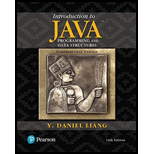
Concept explainers
(Math: pentagonal numbers) A pentagonal number is defined as n(3n − 1)/2 for n = 1, 2, ... , and so on. Therefore, the first few numbers are 1, 5, 12, 22, .... Write a method with the following header that returns a pentagonal number:
public static int getPentagonalNumber(int n)
For example, getPentagonal Number (1) returns 1 and getPentagonalNumber(2) returns 5. Write a test
Program Plan:
- Declare the class “Penta”
- Definition for main class
- Use for loop to iterate the variable “j” equals to “100”.
- Check whether “j” mod “10” equals to 0.
- Call the method “getPentagonalNumber()”.
- Otherwise, call the method “getPentagonalNumber()” concatenate with space.
- Method definition for “getPentagonalNumber()”
- Return “n * (3 * n - 1) / 2”.
Program to display first 100 pentagonal numbers with 10 numbers on each line using the method “getPentagonalNumber ()”
Explanation of Solution
Program:
//Definition for class "Penta"
public class Penta
{
//Definition for main class
public static void main(String[] args)
{
//For loop to iterate the variable
for (int j = 1; j <= 100; j++)
//Check whether the variable "j" mod 10 equals to "0"
if (j % 10 == 0)
//Call the method "getPentagonalNumber"
System.out.println(getPentagonalNumber(j));
else
//Call the method "getPentagonalNumber"
System.out.print(getPentagonalNumber(j) + " ");
}
//Method definition for "getPentagonalNumber"
public static int getPentagonalNumber(int n)
{
//Return the result
return n * (3 * n - 1) / 2;
}
}
1 5 12 22 35 51 70 92 117 145
176 210 247 287 330 376 425 477 532 590
651 715 782 852 925 1001 1080 1162 1247 1335
1426 1520 1617 1717 1820 1926 2035 2147 2262 2380
2501 2625 2752 2882 3015 3151 3290 3432 3577 3725
3876 4030 4187 4347 4510 4676 4845 5017 5192 5370
5551 5735 5922 6112 6305 6501 6700 6902 7107 7315
7526 7740 7957 8177 8400 8626 8855 9087 9322 9560
9801 10045 10292 10542 10795 11051 11310 11572 11837 12105
12376 12650 12927 13207 13490 13776 14065 14357 14652 14950
Want to see more full solutions like this?
Chapter 6 Solutions
Introduction to Java Programming and Data Structures, Comprehensive Version (11th Edition)
Additional Engineering Textbook Solutions
INTERNATIONAL EDITION---Engineering Mechanics: Statics, 14th edition (SI unit)
Starting Out with Java: From Control Structures through Data Structures (4th Edition) (What's New in Computer Science)
SURVEY OF OPERATING SYSTEMS
Modern Database Management
Starting Out with Python (4th Edition)
Introduction To Programming Using Visual Basic (11th Edition)
- "Do not use AI tools. Solve the problem by hand on paper only and upload a photo of your handwritten solution."arrow_forward"Do not use AI tools. Solve the problem by hand on paper only and upload a photo of your handwritten solution."arrow_forward"Do not use AI tools. Solve the problem by hand on paper only and upload a photo of your handwritten solution."arrow_forward
- "Do not use AI tools. Solve the problem by hand on paper only and upload a photo of your handwritten solution."arrow_forwardSolve this "Do not use AI tools. Solve the problem by hand on paper only and upload a photo of your handwritten solution."arrow_forward"Do not use AI tools. Solve the problem by hand on paper only and upload a photo of your handwritten solution."arrow_forward
- "Do not use AI tools. Solve the problem by hand on paper only and upload a photo of your handwritten solution."arrow_forwardSpecifications: Part-1Part-1: DescriptionIn this part of the lab you will build a single operation ALU. This ALU will implement a bitwise left rotation. Forthis lab assignment you are not allowed to use Digital's Arithmetic components.IF YOU ARE FOUND USING THEM, YOU WILL RECEIVE A ZERO FOR LAB2!The ALU you will be implementing consists of two 4-bit inputs (named inA and inB) and one 4-bit output (named out). Your ALU must rotate the bits in inA by the amount given by inB (i.e. 0-15).Part-1: User InterfaceYou are provided an interface file lab2_part1.dig; start Part-1 from this file.NOTE: You are not permitted to edit the content inside the dotted lines rectangle. Part-1: ExampleIn the figure above, the input values that we have selected to test are inA = {inA_3, inA_2, inA_1, inA_0} = {0, 1, 0,0} and inB = {inB_3, inB_2, inB_1, inB_0} = {0, 0, 1, 0}. Therefore, we must rotate the bus 0100 bitwise left by00102, or 2 in base 10, to get {0, 0, 0, 1}. Please note that a rotation left is…arrow_forwardSolve this "Do not use AI tools. Solve the problem by hand on paper only and upload a photo of your handwritten solution."arrow_forward
- Solve this "Do not use AI tools. Solve the problem by hand on paper only and upload a photo of your handwritten solution."arrow_forward"Do not use AI tools. Solve the problem by hand on paper only and upload a photo of your handwritten solution."arrow_forwardSolve this "Do not use AI tools. Solve the problem by hand on paper only and upload a photo of your handwritten solution."arrow_forward
- Programming Logic & Design ComprehensiveComputer ScienceISBN:9781337669405Author:FARRELLPublisher:Cengage
 C++ Programming: From Problem Analysis to Program...Computer ScienceISBN:9781337102087Author:D. S. MalikPublisher:Cengage Learning
C++ Programming: From Problem Analysis to Program...Computer ScienceISBN:9781337102087Author:D. S. MalikPublisher:Cengage Learning EBK JAVA PROGRAMMINGComputer ScienceISBN:9781337671385Author:FARRELLPublisher:CENGAGE LEARNING - CONSIGNMENT
EBK JAVA PROGRAMMINGComputer ScienceISBN:9781337671385Author:FARRELLPublisher:CENGAGE LEARNING - CONSIGNMENT  Microsoft Visual C#Computer ScienceISBN:9781337102100Author:Joyce, Farrell.Publisher:Cengage Learning,
Microsoft Visual C#Computer ScienceISBN:9781337102100Author:Joyce, Farrell.Publisher:Cengage Learning, C++ for Engineers and ScientistsComputer ScienceISBN:9781133187844Author:Bronson, Gary J.Publisher:Course Technology Ptr
C++ for Engineers and ScientistsComputer ScienceISBN:9781133187844Author:Bronson, Gary J.Publisher:Course Technology Ptr EBK JAVA PROGRAMMINGComputer ScienceISBN:9781305480537Author:FARRELLPublisher:CENGAGE LEARNING - CONSIGNMENT
EBK JAVA PROGRAMMINGComputer ScienceISBN:9781305480537Author:FARRELLPublisher:CENGAGE LEARNING - CONSIGNMENT





